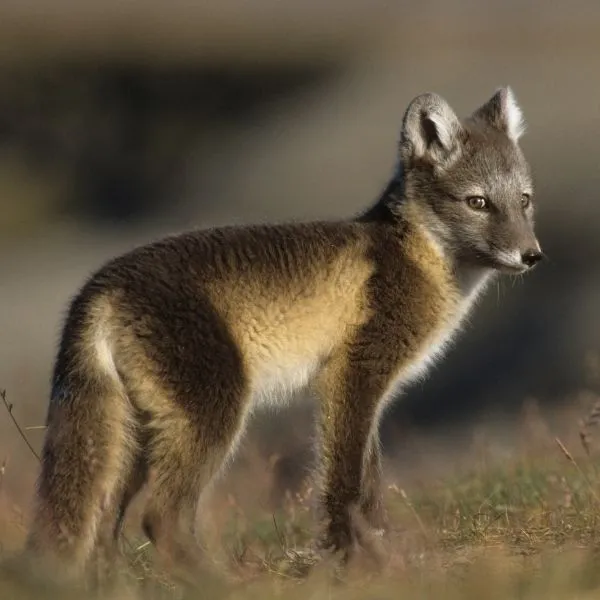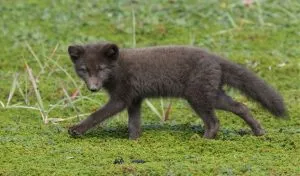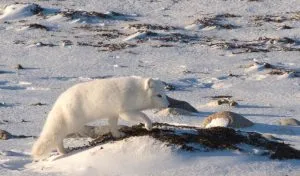The arctic fox is a member of the candid family, similar to other foxes, wolves, and domestic dogs. However, they live in the arctic tundra so they’ve adapted to living in extreme weather conditions. Although in some areas, they are rarely seen anymore, so are they endangered?
The arctic fox is not endangered and has been rated as ‘least concern’ by the IUCN. However, populations in parts of Fennoscandia are critically endangered due to the impacts of climate change such as habitat loss, vulnerability to predators, and red foxes encroaching on their territory.
In this article, we’ll take a look at the numbers and the reasons why arctic foxes are endangered in some regions but not others.
Is The Arctic Fox Endangered?
No, the arctic fox has been rated as ‘least concern’ by the International Union for Conservation of Nature (IUCN) which means they are not an endangered species1 (source: ICUN).
This means they have had their population evaluated and are not classed as being threatened or near threatened.
In most regions where arctic foxes are found, they are abundant with those living on islands in the arctic and at high altitudes being the safest as they will be among the last to face changes in their habitat.
However, specific populations in Fennoscandia are facing trouble. Arctic foxes are classified as critically endangered in Norway, endangered in Sweden, and are extinct in Finland2 (source: Polar Research, A. Landa, Vol 36, Issue 9, 2017).
However, conservation efforts are attempting to bring them back to Finland with some seen denning in the country for the first time since 1996 although they have not yet bred in the country3 (source: WWF).
How Many Arctic Foxes Are Left in the World?
The World Wildlife Fund (WWF) estimates that there are several hundred thousand arctic foxes left in the world4 (source: WWF) and other estimates put the number somewhere between 330,000 – 930,000. These are mostly found in Canada and Alaska.
However, those found in Fennoscandia are considerably lower. For example, in Sweden, numbers dropped as low as just 30 in 1980 but thanks to the efforts of the WWF and other organizations this is now on the rise5 (source: WWF).
Even areas such as Iceland where the population has been rising since monitoring began in 1979 have started to experience a fall since 20106 (source: Icelandic Magazine).
There are two types, the common white morph arctic fox and a rarer blue morph arctic fox which is found in coastal areas. Estimates suggest that the white morph accounts for 99% of the total population7 (source: Wikipedia).
Why is the Arctic Fox Endangered?
Most of the reasons that arctic foxes are endangered in certain areas can be traced back to climate change. These include changes in prey, habitat loss, melting sea ice, and more predators.
Let’s take a look at each of these:
Changes in Prey Abundance
Arctic foxes have two different diets depending upon where they live. Those found inland will primarily feed on small rodents such as lemmings and voles, whereas those in coastal areas will feed on seabirds, fish, and other marine invertebrates8 (source: Journal of Zoology Vol 251, Issue 2, Feb 2006).
The lemming population has always fluctuated with peaks every 3-5 years leading to an unstable diet for inland arctic foxes. They have adapted by aligning reproduction with peak lemming cycles.
However, peak lemming years have been fewer and far between since 1994 in some regions such as Norweigian alpine, a trend that has been linked to climate change and is likely to expand to other regions9 (source: Linking climate change to lemming cycles, 2008).
Lemmings do not hibernate in winter and rely on snow burrows to protect them from harsh weather conditions. Arctic foxes do not need to hibernate as they are still able to hunt lemmings in the winter along with other sources such as carcasses left behind by polar bears.
Mild weather and wet snow lead to these burrows collapsing and ice crust formation makes food plants inaccessible10 (source: ICUN). These factors are likely to result in fewer peak cycles of rodents and therefore less prey for the inland arctic foxes.
See our full article to find out more about what arctic foxes eat.
Habitat Loss
According to the ICUN, habitat loss is the biggest threat to the arctic fox that arises from climate change11 (source: ICUN).
The warming temperatures allow new plant species to thrive in the tundra where arctic foxes live. This is resulting in their habitats turning into forests which is less favorable to the arctic fox.
This is also resulting in red foxes moving into their territory, more on this below.
Melting Sea Ice
During winter, most arctic foxes do not migrate but are known to take ‘commuter’ trips to nearby sea ice where they will feed off the seal carcasses left behind by polar bears. As the sea ice melts and the polar bear population declines, there is less winter food for arctic foxes.
For the small proportion that do migrate, melting sea ice is an even bigger problem. This is because moving sea ice is a vital way of transporting themselves between continents in search of other populations and food12 (source: The Guardian).
However, this melting sea ice is a double-edged sword as it also reduces access to these areas for red foxes traveling from the continent who would otherwise prey on the arctic fox.
More Vulnerability to Predators
Arctic foxes have adapted to the arctic tundra with fur that changes color to help them blend in with their surroundings. In summer, it is brown/gray to blend in with the rocky landscape, whereas they grow a thicker white coat to camouflage against the snow in winter.
However, the changing climate can result in a mismatch between their coat and the surroundings which makes them more vulnerable to predators13 (source: Climate Change Biology, L. Hannah, 2011).
See our full guide to find out more about the predators of the arctic fox.

Increased Competition with Red Foxes
One predator taking advantage of the changing habitats in the tundra is the red fox.
Reduced snow cover in some areas renders the camouflage of the arctic fox’s white winter coat to be less effective14 (source: Climate Change Biology, L. Hannah, 2011). Add to this the spread of new forest areas due to rising temperatures in the tundra and it has created an ideal opportunity for the red fox to encroach into more northern areas that have typically been the territory of the arctic fox.
They compete for the same food and with red foxes being better hunters, they have become more dominant15 (source: ICUN).
Red foxes have become the main predator of arctic foxes as a way of eliminating the competition for resources (known as intraguild predation) and often feeding on them too.
It is estimated that arctic foxes cannot breed within 8km of a red fox den without the significant risk that the red foxes will kill their young16 (source: The Biology and Conservation of Wild Canids, D.W.Macdonald and C. Sillero-Zubiri, 2004).
Genetic Pollution from Farmed Foxes
The World Wildlife Fund for Nature (WWF) also lists disease and genetic pollution of the species by foxes bred in captivity as a key threat to arctic foxes17 (source: WWF).
Researchers have noted that escaped farm foxes have been breeding with arctic foxes in southwest Norway18 (source: Animal Conservation Vol 12, Issue 5, 2009).
Arctic foxes have a breeding cycle aligned with peak lemming cycles which enables them to survive. However, researchers think that outbreeding with farm foxes might result in the loss of this alignment and cause a threat to the species.
Action against this can be controversial as it would involve culling arctic foxes that have been bred from farm foxes.
Hunting by Humans
Hunting of arctic foxes for their fur has had a detrimental impact on the population in Fennoscandia where the population is now most at risk. At one point, the pelt of an arctic fox (skin and fur) would sell for anywhere between $50,000 and $2,000,00019 (source: The dynamics of Canadian arctic fox populations, Vol 8, 1969).
However, due to awareness of this issue and a downturn in the demand for fur, this is much less of an issue in recent times20 (source: WWF).
Although native populations such as Inuits who live near arctic foxes are still known to frequently hunt them for fur.
.
Why Are Arctic Foxes Important?
As with all animals, arctic foxes are important to control the population of their prey which is rodents such as lemmings.
Although scarce for many years at a time, during peak lemming years there could be as many as 3,000 lemmings per 100,000 square miles, compared to just 1 lemming per 100,000 square miles in other years. Arctic foxes play a major role in controlling these numbers21 (source: BBC).
Arctic foxes also play a role in increasing soil nutrients. It was noted that the soil around their dens contained higher nutrient levels which lead to increased plant productivity in these areas22 (source: Nature.com, Scientific Report, 2016).
How Can We Help Save The Arctic Fox?
Even in areas of Fennoscandia where the arctic fox population is critically endangered, not all hope is lost.
There are several ways we can help save the arctic fox in Fennoscandia including supplementary feeding, red fox hunting, and captive breeding programs which have already been successful. Although ultimately, we need to stop climate change to fully protect them.
Let’s take a look at each of these and how they are helping:
1. Red Fox Hunting and Supplementary Feeding
As mentioned earlier, the increase in the red fox population has posed a big threat to arctic foxes.
In Finland and Sweden, a program called Save the Endangered Fennoscandian Alopex (SEFALO) took place in 2000 that saw red fox culling during winter at traditional arctic fox territories by rangers with special permits from national authorities.
This coincided with supplementary feeding programs in which fox dens were provided with commercial dog food to help with food scarcity.
These regions saw a four-fold increase in the population of arctic foxes which was attributed equally to lemming abundance during the period and the conservation action23 (source: Journal of Applied Ecology, A. Angerbjörn. et al, Vol 50, 2013).
Supplementary feeding programs can also be found in Finland.
2. Captive Breeding Programs
Another example of a practical thing we can do to save arctic foxes is captive breeding programs. These have been used in Fennoscandia to boost the number of foxes in the wild.
The program was used to boost numbers of arctic foxes in the early 2000s, introducing around 385 pups to the wild during the first half of the decade. They were released each winter into artificially made dens and have helped with the survival of the population24 (source: Polar Research, A. Land. et al, Vol 36, Issue 9, 2017).
3. Stop Climate Change
Ultimately, these are all short to mid-term solutions but the only way to ensure the long-term survival of the arctic fox in Fennoscandia and across the world is to eliminate climate change and stop temperatures from rising.
This will stop the negative impact of red foxes from moving their territories and preying on them as well as ensuring the lemming cycles continue to provide peak reproductive periods.




![Read more about the article Why Do Arctic Foxes Change Color? [Summer vs Winter Coat]](https://polarguidebook.com/wp-content/uploads/2021/07/Arctic-Foxes-Summer-vs-Winter-300x176.jpg)
